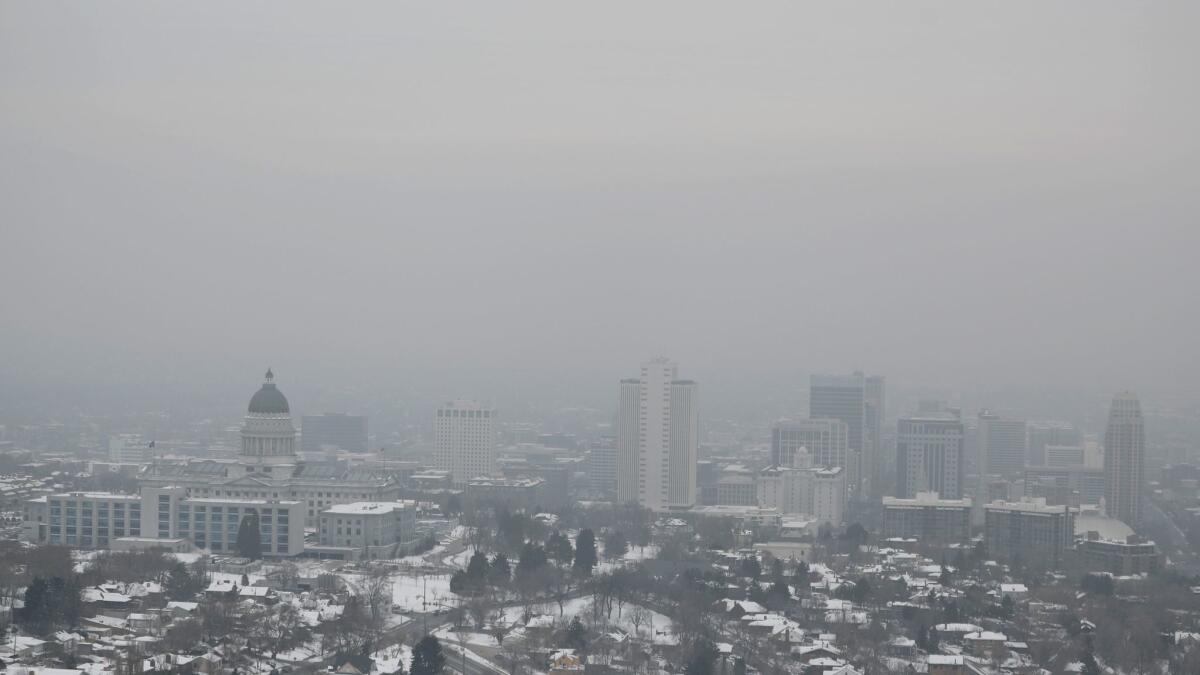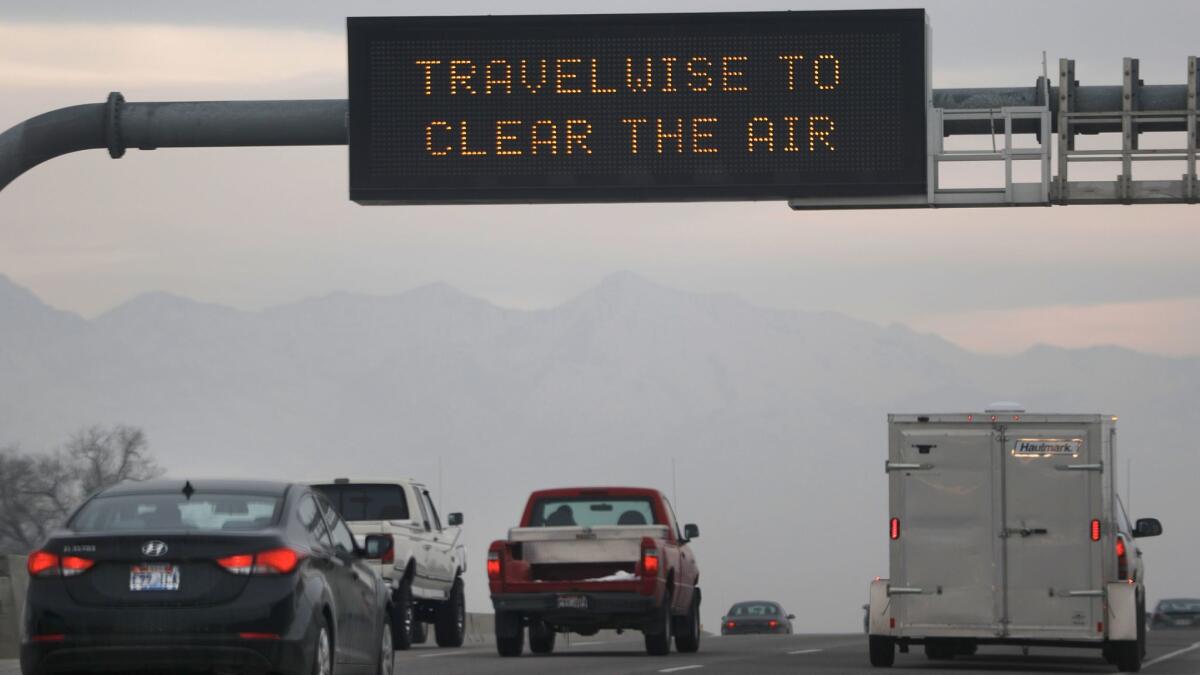Utah is the land of ski runs, pristine parks and a really bad smog problem

- Share via
Reporting from Salt Lake City — The air hung heavy in the valley like damp, dirty cotton balls stagnating in a frigid bowl.
It’s winter in Salt Lake City, and as smog is prone to do, it settled in for a spell this week. Some people walking downtown wore surgical masks. Schools kept kids inside during recess. A few folks headed to the mountains to relieve itchy eyes and scratchy throats.
For the record:
8:10 p.m. Feb. 2, 2017An earlier version of this story identified Ben McAdams as mayor of Salt Lake City. He is mayor of Salt Lake County.
On Wednesday, the Environmental Protection Agency dinged the region with the dubious distinction of having the worst air quality in the nation — and it was likely to be in the top spot Thursday as well.
“It’s so gross,” Holly Sorensen said.
Sorensen drove up to Park City with her three children to escape the foul air. Standing near the bunny slope as 3-year-old Emmett tossed a snowball at her, she dreaded the depressing descent into the valley and through the wall of gray gunk to her home.
“You feel helpless,” she said. “I don’t really know what else to do.”
For a long time, neither did Utah.
Though smog has been settling over the Salt Lake City area for years, Utah officials have taken little action — it just hadn’t been a priority.

That changed in 2013, when the state failed EPA clean-air standards on 38 days of the year — including at least one day when the pollution level was worse than Beijing’s.
Public opinion polls started showing air quality as a top concern for almost everybody. And state officials started moving.
Bryce Bird, air quality division director for the Utah Department of Environmental Quality, says air quality has improved since then through a series of measures enacted by the Legislature, including tax incentives for clean-fuel vehicles, a requirement that new water heaters must have the latest technology for reducing nitrogen oxides, and a program that replaced more than 1,600 pieces of gas-powered lawn and garden machines with electric ones.
“We passed more clean-air legislation in 2014 than in the previous 100 years combined,” said Republican state Sen. Todd Weiler.
Since 2013, the region has been out of compliance with EPA air quality standards for a total of 32 days. Weiler says that on average, Utah’s urban areas meet federal air quality standards 95% of the days each year, and that the annual average pollution standards meet federal standards.
But cutting down on emissions is one aspect of the problem. The other part is out of the region’s control entirely.
John Lin, associate professor of atmospheric sciences at the University of Utah, said weather and geography combine to set a trap for bad air during the winter.
He said the mountains surrounding the area trap pollution. When snow is on the ground, the surface temperature cools with it. High pressure sits on top of the cool air, pushing it down and forming a lid. Once the lid is on, emissions can’t disperse and the air gets worse.
“The relief comes when a low-pressure system comes in,” he said. “That blows it out.”
While the pollution is around, however, the lingering effect can seem as frustrating as it is sickening.
Doug Wright, who hosts a popular radio program, bemoaned the “inversion” — the short-hand, catch-all term used by residents to describe the bad air on Wednesday when the region achieved its status as having the worst air quality that day.

During a phone interview with Wright, Salt Lake County Mayor Ben McAdams noted he was standing at the Capitol — high above the downtown area — and couldn’t see the county building just a few miles away.
“Thank goodness we didn’t have it during Sundance [Film Festival] — we had some air quality problems, but it’s not as bad as it is today,” McAdams told Wright. “People come to Sundance and this is often their first impression of Utah, and they leave seeing this poor air quality, and that sticks with them and it hurts … our ability to attract businesses, to attract tourism.”
Indeed, for newcomers to Utah who were lured by photographs of sparkling ski runs or majestic national parks, the smoky skies come as a shock and surprise.
State Rep. Patrice Arent, a Democrat who formed the Clean Air Caucus a few years ago, says places in the state untouched by bad air are affected by the images of a toxic cloud over Salt Lake City, as they are spread easily over social media.
“They think it’s the whole state,” Arent said. “I’m involved with Boulder, Utah, and the air down there is absolutely pristine. It’s gorgeous. But the lodges down there get calls asking if the air is bad.”
Because pollution’s profile has been raised since 2013, there are bills being run this Legislative session aimed at getting high-polluting buses off the roads and requiring stricter testing on diesel vehicles. A resolution encourages people to buy cars not just based on gas mileage, but on emissions ratings.
Republican Gov. Gary R. Herbert has also pushed for cleaner air, forming a nonprofit aimed at pollution solutions and taking part in a forum on the issue. And in his State of the State speech Jan. 25, he said the pollution problem “worries” him and he is seeking to use $35 million of the settlement being paid by Volkswagen in a nationwide emissions cheating case to target diesel engine pollution.
Weiler, the state senator, said the biggest improvements to air quality have been driven by the federal government, not the state.
“As a Republican, it pains me to admit it, but that’s because of the Clean Air Act and because of the EPA,” Weiler said.
In the free market, he said, there is no incentive not to pollute. “In fact,” Weiler added,” the incentive is to pollute as much as you can get away with, unfortunately. And it pains me to say that, but the Clean Air Act is working and that’s a big reason why our air is getting cleaner.”
He says the Republican-dominated Legislature is trying to balance people’s freedom with bills aimed at targeting pollution spikes during the winter months when the smoggy inversion grips the area.
Weiler says people tend to “scapegoat” rather than look at their own lives to see how they can help reduce the problem.
“It’s not like we have our hand on the solution and we’re not willing to push the lever to do it,” he said. “There is no viable solution short of telling people you can no longer live your lives the way you want to.”
By Thursday afternoon, the inversion was still stubbornly hovering around the city. But relief was allegedly on the way.
Grant Weyman, a weatherman on local television station KSL, said Thursday that there was “hope” for the weekend.
“Sunday looks partly cloudy,” he said. “Clean air conditions. Not bad.”
More to Read
Sign up for Essential California
The most important California stories and recommendations in your inbox every morning.
You may occasionally receive promotional content from the Los Angeles Times.










